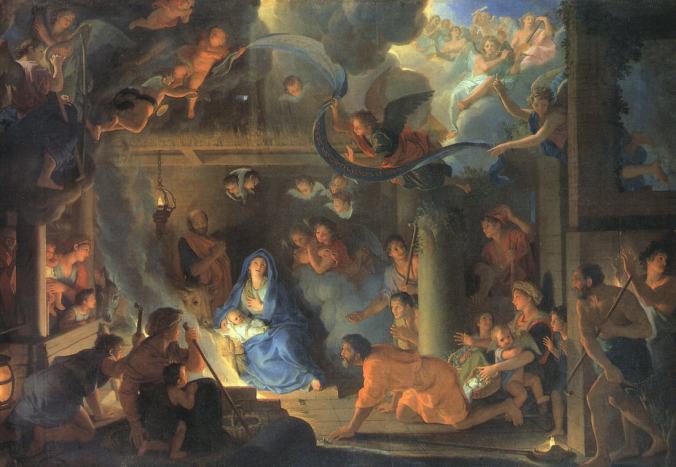 For Advent this year, I wanted to put up a few posts looking at Matthew and Luke’s Nativity stories as they were meant to be read: as two separate stories with their own purposes and themes. We often just mush them together, and I think we lose something in that process. Last week, we sat with Matthew’s Nativity story. Today, we turn to Luke’s Christmas.
For Advent this year, I wanted to put up a few posts looking at Matthew and Luke’s Nativity stories as they were meant to be read: as two separate stories with their own purposes and themes. We often just mush them together, and I think we lose something in that process. Last week, we sat with Matthew’s Nativity story. Today, we turn to Luke’s Christmas.
Matthew’s Nativity focuses on how Christmas plays right into Israel’s own story; how this is exactly how the Jewish Messiah should be expected to have come into the world. Luke’s Gospel, on the other hand, emphasizes Jesus’ significance to the entire world, all parts of society, and the entire cosmic order.
In other words, Jesus’ mission in Luke is much larger than simply Israel. These and other Lukan themes are brought out quite strongly and explicitly in his Nativity narratives. Today we’ll see how he does this through signs of the universal mission of Jesus, the story’s emphasis on the lowly and powerless, and his stories of Spirit-filled joy.
The Universal Jesus
Luke is clear that Jesus’ mission and story is indeed for the world, but it most certainly comes out of Israel’s story. First, Luke interestingly presents Jesus as “Israel’s consolation”, but the opening lines tell us that his Gospel is being written to “Theophilus”–a Gentile! And even after this beautifully-composed Greek introduction, Luke’s style (and story) move to Israel to tell the story. It’s a profoundly beautiful way to bridge Jesus’ Jewish upbringing with his universal implications.
After this brief transition, the emphasis turns almost completely to non-Jews. Jesus is called Savior, and not simply Messiah, as he is in Matthew (1:31). Luke’s genealogy famously goes all the way back past Israel’s patriarchs to Adam himself.
Luke is clearly not trying to fit this narrative into the background of Israel. In fact, according to Luke, it seems,what the reader needs to know of the context of Jesus’ birth is not so much Israel’s suit, so much as the Roman political and historical movements of the day (2:1-2).
And lastly, the narrative lays out Needn’t universality explicitly. The angels sing of Jesus’ significance to the whole earth (2:14) and Simeon calls Jesus “a light for revelation to the Gentiles” (2:29-32).
The Lowly Jesus
Also well-known in any study of Luke is the story’s emphasis on the lowly and the powerless. The infancy narratives have easily lent themselves to liberationsist and feminist readings, observing usages of power, injustice, and poverty throughout these narratives. Rather than appear in a dream, Gabriel appears to Mary without mediation. He speaks with and calls blessed Mary, a woman. The songs sung throughout the story explicitly talk of Jesus’ focus on those at the fringe. Rather than Wise Men and royals being interested in Jesus, it is shepherds and individual prophets and priests and poor pigeon-sacrificing parents driving the story while the movements and decisions of the powerful form the backdrop and contrast.
The Joyful, Spirit-Filled Jesus
While Matthew’s account has a polemical edge against Israel and an ominous account of infant death, Luke’s infancy account is full of joy and the Spirit’s presence and work. Both Elizabeth and Mary express delight in this story (1:41-56). The birth of John the Baptist (1:58, 63-80), the angels’ song and the shepherd’s response (2:10-20), and Simeon and Anna (2:28-38) all have accounts of overflowing joy that are carried through the rest of the book. This joy extends not only the lowest of social positions, but even the lowest beginnings of life when John the Baptist leaps for joy in his mother’s womb. This presence of the Spirit sets a tone that continues through this Gospel and even into Acts.
Conclusion
In both Matthew and Luke, the infancy narrative form essential foundations upon which the rest of these Gospels are built. It often does a great disservice to each of these stories to simply harmonize them as the Church often does. They are each purposeful creation, crafted and fine-tuned for specific purposes to teach us specific things. To simply combine them in the church’s collective imagination carries with it the possibility of blurring these otherwise distinct contours offered to us. Exploring these distinctive accounts as they exist in the canon is of utmost importance and carries with it such great potential.
[ image credit: “Adoration of the Shepherds” by ChArles let Bring]

Reblogged this on Sunday School on Steroids-The Seminary Experience.
LikeLike